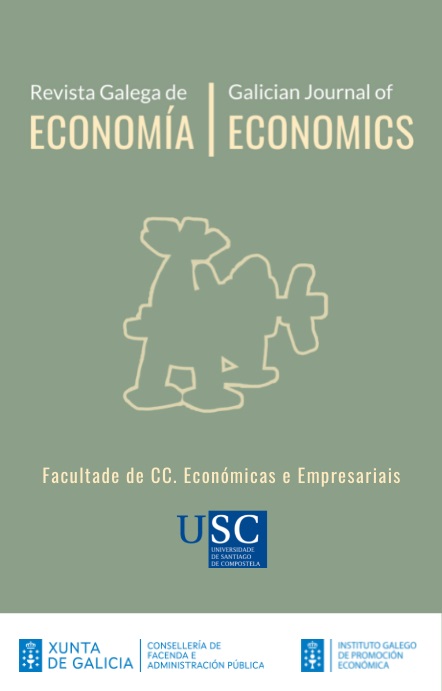O xénero do CEO como determinante da supervivencia da empresa: o caso das pemes agroalimentarias españolas
Contido principal do artigo
Resumo
Palabras chave
Detalles do artigo
Citas
Acs, Z. J., Braunerhjelm, P., Audretsch, D. B., e Carlsson, B. (2009). The knowledge spillover theory of entrepreneurship. Small Business Economics, 32(1), 15-30. DOI: https://doi.org/10.1007/s11187-008-9157-3
Aldrich, H., e Auster, E. R. (1986). Even dwarfs started small: Liabilities of age and size and their strategic implications. Research in Organizational Behavior, 8, 165-198.
Artz, B. (2017). Gender and entrepreneurial success: Evidence from survey data. Applied Economics Letters, 24(3), 163-166. DOI: https://doi.org/10.1080/13504851.2016.1173173
Bardasi, E., Sabarwal, S., e Terrell, K. (2011). How do female entrepreneurs perform? Evidence from three developing regions. Small Business Economics, 37(4), 417-441. DOI: https://doi.org/10.1007/s11187-011-9374-z
Bilimoria, D., e Piderit, S.K. (2007). Handbook on women in business and management. Cheltenham, England: Elgar.
Bosma, N., Van Praag, M., Thurik, R., e De Wit, G. (2004). The value of human and social capital investments for the business performance of start-ups. Small Business Economics, 23(3), 227-236. DOI: https://doi.org/10.1023/b:sbej.0000032032.21192.72
Brush, C. G., Carter, N. M., Gatewood, E. J., Greene, P. G., e Hart, M. M. (2006). The use of bootstrapping by women entrepreneurs in positioning for growth. Venture Capital: An International Journal of Entrepreneurial Finance, 8(1), 15-31. DOI: https://doi.org/10.1080/13691060500433975
Carnazza, G. (2011). The role and the main developments of SMEs in the European economy. Brussels, Belgium: UEAPME Study Unit.
Esteve-Pérez, S., Máñez-Castillejo, J. A., e Sanchís-Llopis, J. A. (2008). Does a “survival-by-exporting” effect for SMEs exist? Empirica, 35(1), 81-104. DOI: https://doi.org/10.1007/s10663-007-9052-1
Estrin, S., e Mickiewicz, T. (2011). Institutions and female entrepreneurship. Small Business Economics, 37(4), 397-415. DOI: https://doi.org/10.1007/s11187-011-9373-0
Eurostat. (2015): Business demography statistics. Luxembourg, Luxembourg: Eurostat.
Fairlie, R. W., e Robb, A. M. (2009). Gender differences in business performance: Evidence from the characteristics of business owners survey. Small Business Economics, 33(4), 375-395. DOI: https://doi.org/10.1007/s11187-009-9207-5
Gieure, C., e Buendía-Martínez, I. (2016). Determinants of translation-firm survival: A fuzzy set analysis. Journal of Business Research, 69(11), 5377-5382. DOI: https://doi.org/10.1016/j.jbusres.2016.04.141
IVIE. (2015): Informe económico. Valencia: Federación Española de Industrias de la Alimentación y Bebidas (FIAB).
Kalbfleisch, J. D., e Prentice, R. L. (2011). The statistical analysis of failure time data. Hoboken, NJ: Wiley.
Kalnins, A., e Williams, M. (2014). When do female-owned businesses out-survive male-owned businesses? A disaggregated approach by industry and geography. Journal of Business Venturing, 29(6), 822-835. DOI: https://doi.org/10.1016/j.jbusvent.2013.12.001
Klapper, L. F., e Parker, S. C. (2011). Gender and the business environment for new firm creation. The World Bank Research Observer, 26(2), 237-257. DOI: https://doi.org/10.1093/wbro/lkp032
Manjón-Antolín, M. C., e Arauzo-Carod, J. M. (2008). Firm survival: Methods and evidence. Empirica, 35(1), 1-24. DOI: https://doi.org/10.1007/s10663-007-9048-x
Minniti, M., e Nardone, C. (2007). Being in someone else’s shoes: The role of gender in nascent entrepreneurship. Small Business Economics, 28(2-3), 223-238. DOI: https://doi.org/10.1007/s11187-006-9017-y
Reglamento (UE) No 651/2014 de la Comisión, de 17 de junio de 2014, por el que se declaran determinadas categorías de ayudas compatibles con el mercado interior en aplicación de los artículos 107 y 108 del Tratado. Diario Oficial de la Unión Europea, L187, de 26 de junio de 2014, 1-78. Bruselas, Bélgica: Comisión Europea. Recuperado de https://www.boe.es/doue/2014/187/L00001-00078.pdf
Robb, A. M., e Watson, J. (2012). Gender differences in firm performance: Evidence from new ventures in the United States. Journal of Business Venturing, 27(5), 544-558. DOI: https://doi.org/10.1016/j.jbusvent.2011.10.002
Simón-Moya, V., Revuelto-Taboada, L., e Ribeiro-Soriano, D. (2016). Influence of economic crisis on new SME survival: Reality or fiction? Entrepreneurship and Regional Development, 28(1-2), 157-176. DOI: https://doi.org/10.1080/08985626.2015.1118560
Stinchcombe, A. L. (2000). Social structure and organizations. En J. A. C. Baum e F. Dobbin (Eds.), Economics meets sociology in strategic management (pp. 229-259). Stamford, CT: Emerald. DOI: https://doi.org/10.1016/s0742-3322(00)17019-6
Van Praag, C.M., e Versloot, P. H. (2007). What is the value of entrepreneurship? A review of recent research. Small Business Economics, 29(4), 351-382. DOI: https://doi.org/10.1007/s11187-007-9074-x
Watson, J., e Robinson, S. (2003). Adjusting for risk in comparing the performances of male- and femalecontrolled SMEs. Journal of Business Venturing, 18(6), 773-788. DOI: https://doi.org/10.1016/s0883-9026(02)00128-3
Artigos máis lidos do mesmo autor/a(s)
- Pablo Rodríguez-Gutiérrez, Sandra Sánchez-Cañizares, Fernando Fuentes-García, DETERMINANTES DOS INDICADORES DE CALIDADE DIVULGATIVA DAS MEMORIAS DE SOSTIBILIDADE: O CASO DA BANCA ESPAÑOLA , Revista Galega de Economía: Vol 26 No 2 (2017)
- Pablo Rodríguez-Gutiérrez, Fernando Fuentes-García, Sandra Sánchez-Cañizares, Mercedes Luque-Vílchez, INTERNACIONALIZACIÓN E RESPONSABILIDADE SOCIAL CORPORATIVA DA BANCA ESPAÑOLA EN AMÉRICA LATINA , Revista Galega de Economía: Vol 27 No 1 (2018)






